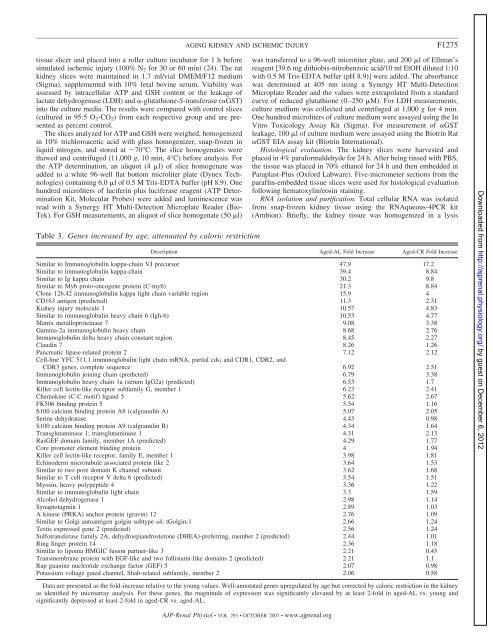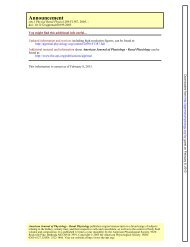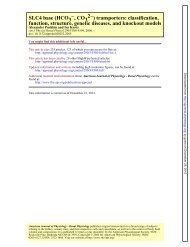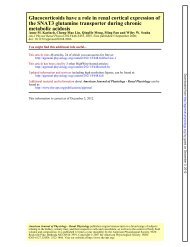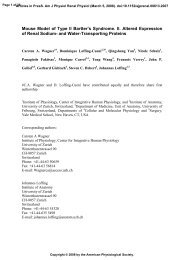Increased susceptibility of aging kidney to ... - Renal Physiology
Increased susceptibility of aging kidney to ... - Renal Physiology
Increased susceptibility of aging kidney to ... - Renal Physiology
You also want an ePaper? Increase the reach of your titles
YUMPU automatically turns print PDFs into web optimized ePapers that Google loves.
tissue slicer and placed in<strong>to</strong> a roller culture incuba<strong>to</strong>r for 1 h before<br />
simulated ischemic injury (100% N2 for 30 or 60 min) (24). The rat<br />
<strong>kidney</strong> slices were maintained in 1.7 ml/vial DMEM/F12 medium<br />
(Sigma), supplemented with 10% fetal bovine serum. Viability was<br />
assessed by intracellular ATP and GSH content or the leakage <strong>of</strong><br />
lactate dehydrogenase (LDH) and �-glutathione-S-transferase (�GST)<br />
in<strong>to</strong> the culture media. The results were compared with control slices<br />
(cultured in 95:5 O2-CO2) from each respective group and are presented<br />
as percent control.<br />
The slices analyzed for ATP and GSH were weighed, homogenized<br />
in 10% trichloroacetic acid with glass homogenizer, snap-frozen in<br />
liquid nitrogen, and s<strong>to</strong>red at �70°C. The slice homogenates were<br />
thawed and centrifuged (11,000 g, 10 min, 4°C) before analysis. For<br />
the ATP determination, an aliquot (4 �l) <strong>of</strong> slice homogenate was<br />
added <strong>to</strong> a white 96-well flat bot<strong>to</strong>m microliter plate (Dynex Technologies)<br />
containing 6.0 �l <strong>of</strong> 0.5 M Tris-EDTA buffer (pH 8.9). One<br />
hundred microliters <strong>of</strong> luciferin plus luciferase reagent (ATP Determination<br />
Kit, Molecular Probes) were added and luminescence was<br />
read with a Synergy HT Multi-Detection Microplate Reader (Bio-<br />
Tek). For GSH measurements, an aliquot <strong>of</strong> slice homogenate (50 �l)<br />
AGING KIDNEY AND ISCHEMIC INJURY<br />
Table 3. Genes increased by age, attenuated by caloric restriction<br />
was transferred <strong>to</strong> a 96-well microtiter plate, and 200 �l <strong>of</strong> Ellman’s<br />
reagent [39.6 mg dithiobis-nitrobenzoic acid/10 ml EtOH diluted 1:10<br />
with 0.5 M Tris-EDTA buffer (pH 8.9)] were added. The absorbance<br />
was determined at 405 nm using a Synergy HT Multi-Detection<br />
Microplate Reader and the values were extrapolated from a standard<br />
curve <strong>of</strong> reduced glutathione (0–250 �M). For LDH measurements,<br />
culture medium was collected and centrifuged at 1,000 g for 4 min.<br />
One hundred microliters <strong>of</strong> culture medium were assayed using the In<br />
Vitro Toxicology Assay Kit (Sigma). For measurement <strong>of</strong> �GST<br />
leakage, 100 �l <strong>of</strong> culture medium were assayed using the Biotrin Rat<br />
�GST EIA assay kit (Biotrin International).<br />
His<strong>to</strong>logical evaluation. The <strong>kidney</strong> slices were harvested and<br />
placed in 4% paraformaldehyde for 24 h. After being rinsed with PBS,<br />
the tissue was placed in 70% ethanol for 24 h and then embedded in<br />
Paraplast-Plus (Oxford Labware). Five-micrometer sections from the<br />
paraffin-embedded tissue slices were used for his<strong>to</strong>logical evaluation<br />
following hema<strong>to</strong>xylin/eosin staining.<br />
RNA isolation and purification. Total cellular RNA was isolated<br />
from snap-frozen <strong>kidney</strong> tissue using the RNAqueous-4PCR kit<br />
(Ambion). Briefly, the <strong>kidney</strong> tissue was homogenized in a lysis<br />
Description Aged-AL Fold Increase Aged-CR Fold Increase<br />
Similar <strong>to</strong> Immunoglobulin kappa-chain VJ precursor 47.9 17.2<br />
Similar <strong>to</strong> immunoglobulin kappa-chain 39.4 8.84<br />
Similar <strong>to</strong> Ig kappa chain 30.2 9.8<br />
Similar <strong>to</strong> Myb pro<strong>to</strong>-oncogene protein (C-myb) 21.3 8.84<br />
Clone 126.42 immunoglobulin kappa light chain variable region 15.9 4<br />
CD163 antigen (predicted) 11.3 2.31<br />
Kidney injury molecule 1 10.57 4.83<br />
Similar <strong>to</strong> immunoglobulin heavy chain 6 (Igh-6) 10.53 4.77<br />
Matrix metalloproteinase 7 9.08 3.38<br />
Gamma-2a immunoglobulin heavy chain 8.68 2.76<br />
Immunoglobulin delta heavy chain constant region 8.45 2.27<br />
Claudin 7 8.26 1.26<br />
Pancreatic lipase-related protein 2 7.12 2.12<br />
Cell-line YFC 511.1 immunoglobulin light chain mRNA, partial cds; and CDR1, CDR2, and<br />
CDR3 genes, complete sequence 6.92 2.51<br />
Immunoglobulin joining chain (predicted) 6.79 3.38<br />
Immunoglobulin heavy chain 1a (serum IgG2a) (predicted) 6.53 1.7<br />
Killer cell lectin-like recep<strong>to</strong>r subfamily G, member 1 6.23 2.41<br />
Chemokine (C-C motif) ligand 5 5.62 2.67<br />
FK506 binding protein 5 5.54 1.16<br />
S100 calcium binding protein A8 (calgranulin A) 5.07 2.05<br />
Serine dehydratase 4.43 0.98<br />
S100 calcium binding protein A9 (calgranulin B) 4.34 1.64<br />
Transglutaminase 1; transglutaminase 1 4.31 2.13<br />
RasGEF domain family, member 1A (predicted) 4.29 1.77<br />
Core promoter element binding protein 4 1.94<br />
Killer cell lectin-like recep<strong>to</strong>r, family E, member 1 3.98 1.81<br />
Echinoderm microtubule associated protein like 2 3.64 1.53<br />
Similar <strong>to</strong> two pore domain K channel subunit 3.62 1.68<br />
Similar <strong>to</strong> T cell recep<strong>to</strong>r V delta 6 (predicted) 3.54 1.51<br />
Myosin, heavy polypeptide 4 3.36 1.22<br />
Similar <strong>to</strong> immunoglobulin light chain 3.3 1.59<br />
Alcohol dehydrogenase 1 2.98 1.14<br />
Synap<strong>to</strong>tagmin 1 2.89 1.03<br />
A kinase (PRKA) anchor protein (gravin) 12 2.76 1.09<br />
Similar <strong>to</strong> Golgi au<strong>to</strong>antigen golgin subtype a4; tGolgin-1 2.66 1.24<br />
Testis expressed gene 2 (predicted) 2.56 1.24<br />
Sulfotransferase family 2A, dehydroepiandrosterone (DHEA)-preferring, member 2 (predicted) 2.44 1.01<br />
Ring finger protein 14 2.36 1.18<br />
Similar <strong>to</strong> lipoma HMGIC fusion partner-like 3 2.21 0.45<br />
Transmembrane protein with EGF-like and two follistatin-like domains 2 (predicted) 2.21 1.1<br />
Rap guanine nucleotide exchange fac<strong>to</strong>r (GEF) 5 2.07 0.98<br />
Potassium voltage gated channel, Shab-related subfamily, member 2 2.06 0.58<br />
Data are presented as the fold-increase relative <strong>to</strong> the young values. Well-annotated genes upregulated by age but corrected by caloric restriction in the <strong>kidney</strong><br />
as identified by microarray analysis. For these genes, the magnitude <strong>of</strong> expression was significantly elevated by at least 2-fold in aged-AL vs. young and<br />
significantly depressed at least 2-fold in aged-CR vs. aged-AL.<br />
AJP-<strong>Renal</strong> Physiol • VOL 293 • OCTOBER 2007 • www.ajprenal.org<br />
F1275<br />
Downloaded from<br />
http://ajprenal.physiology.org/<br />
by guest on December 6, 2012


